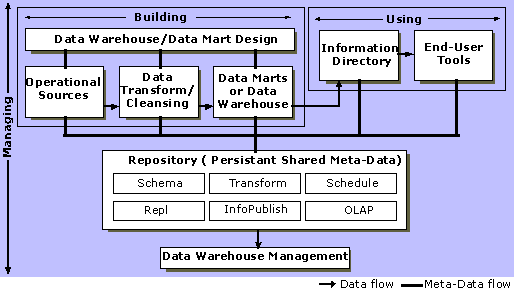
Several years ago, Microsoft undertook a pair of initiatives with the overall goal of expanding the availability of data warehousing and decision support capabilities in the business world. The two initiatives are the Microsoft Data Warehousing Framework, which is a roadmap for Microsoft product development, and the Microsoft Alliance for Data Warehousing, which is a coalition of industry businesses committed to the Microsoft platform and the Data Warehousing Framework for development and marketing purposes. The initiatives were based on a central strategy of Microsoft Corporation contributing to the data warehousing process by:
The Data Warehousing Framework is an open architecture that describes mechanisms for sharing data and metadata in the construction and management of data warehouses and data marts. The essential technologies underlying the Data Warehousing Framework are the OLE DB data interfaces and the instance of Microsoft Repository running on SQL Server.
Repository is a database that stores descriptive information about software components and their relationships (metadata). Metadata models have been defined in Repository for database schemas, data transformations, and OLAP database schemas.
The Data Warehousing Framework components represent integral steps in the data warehousing process, some of which are being delivered by Microsoft but that can be extended easily by Microsoft customers and third-party businesses using alternative technology.
SQL Server 7.0 provides many of the basic components required for building and maintaining a data warehouse: database design with a graphical schema designer; high-capacity data storage; data transformation capabilities through Data Transformation Services (DTS); OLAP capabilities through OLAP Services; and so on.

For more information about the Data Warehousing Framework, see “Data Warehousing Framework” earlier in this volume.